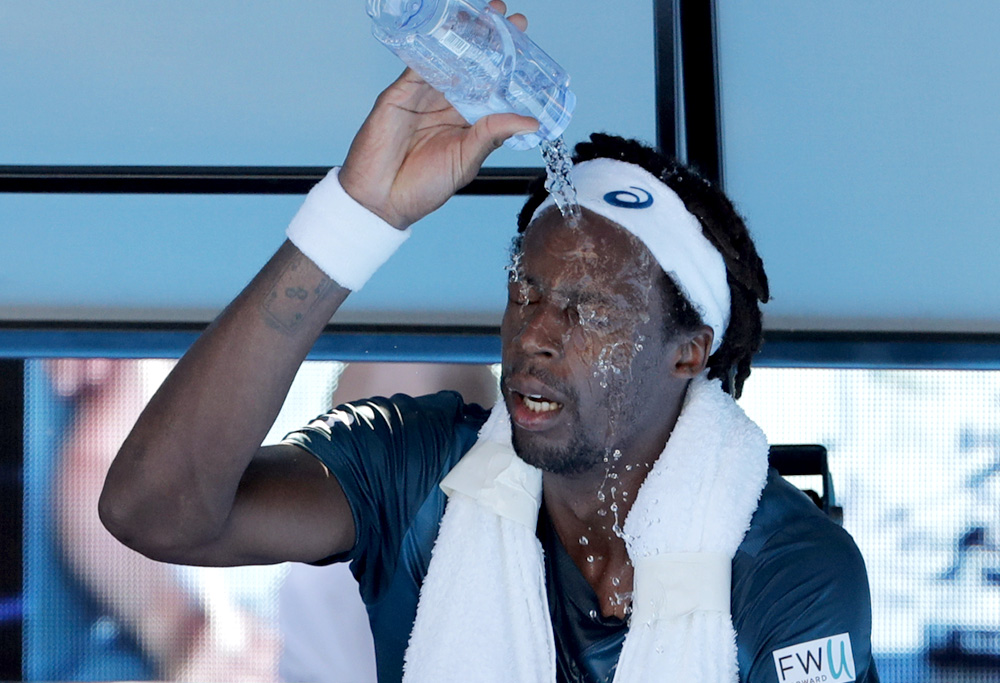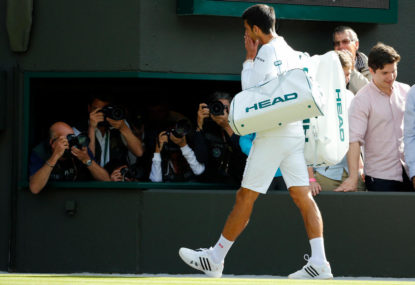Friday night’s Wimbledon semi final marathon between South Africa’s 6′ 8” tall Kevin Anderson (seeded 8) and America’s 6′ 10” tall John Isner (seeded 9) is the catalyst for this article.
The match between the two tall players went on and on for six hours and 35 minutes as the former won 7-6, 6-7, 6-7, 6-4 and 26-24.
This makes me think: Should tie-breakers be introduced in the final deciding set at Wimbledon? What do you say, Roarers? As it stands, only the US Open has tiebreakers in all sets.
In the 2014 French Open, Britain’s Andy Murray, seeded 7, took two days to beat Germany’s 28-seeded Philipp Kohlschreiber 3-6, 6-3, 6-3, 4-6, 12-10.
These two long drawn matches reminded of the tennis marathon of the century between American John Isner (yes, the same tall Isner) and French qualifier Nicolas Mahut in the 2010 Wimbledon.
Isner took three days to defeat Mahut 6-4, 3-6, 6-7, 7-6, 70-68. A set of 70-68 appears like a misprint but it actually happened in June 2010.
The match of 183 games took a total of 11 hours and five minutes over three days from 22 to 24 June to complete. The fifth set alone lasted eight hours, 11 minutes.
Picking up at 59-59 in the fifth set on the third day (24 June, 2010), the match continued on serve with no break points until the American hit a backhand passing shot past the Frenchman in the 138th game of the set to finish the contest in front of a packed audience.
This mega marathon is now referred to as “the endless match”.
In all 216 aces were hit, Isner 113 aces and Mahut 103. All three are records in a match.
After the torrid marathon, both Isner and Mahut as also the umpire were presented with crystal bowls and champagne flutes.
Tennis marathons were commoner before tie-breakers were introduced in all but the final set.
Although frustrating to the tournament organisers, the prolonged “endless” sets had that certain aura, although rich in yawns.
One of the most cliff-hanging marathons was played in Los Angeles in May 1949 when Ted Schroeder and Richard Falkenberg defeated the colourful Pancho Gonzales and H Stewart 36-34, 3-6, 4-6, 6-4, 19-17 in the South California Championships final.
The see-saw tussle between the Americans lasted four hours and 45 minutes as 135 games were hotly contested. A world record? Not quite.
Richard Leach and Richard Dell overcame fellow Americans Tom Mozur and Lenny Schloss 3-6, 49-47, 22-20 at Newport, Rhode Island on 18 to19 August, 1967. That means 147 games, not exactly a landslide victory! The 96 game second set was the longest on record in senior tennis, according to Lance Tingay in The Guinness Book of Facts and Feats.
Of course that was correct before the Isner-Mahut final set (70-68) of titanic dimension in 2010.

France’s Gael Monfils showers himself with water during his second round match against Serbia’s Novak Djokovic (AP Photo/Vincent Thian)
Another marathon to remember was a singles match between Roger Taylor (Great Britain) and Wieslaw Gasiorek (Poland). In a King’s Cup tie at Warsaw, Poland, on five November 1966, Taylor won 27-29, 31-29, 6-4 after four and half hours and 126 games.
Another marathon lasted six hours and 23 minutes for completion. This was in the US Indoor Championships at Salisbury, Maryland on 16 February 1968 when Mark Cox and Bobby Wilson (GB) defeated Charles Pasarell and Bob Holmberg (USA) 26-24, 17-19, 30-28, a mere 144 games!
In a Davis Cup doubles, 95 games were played in the quarter final in Birmingham, UK in 1969 when Wilhelm Bungert and Christian Kuhnke (Germany) beat Mark Cox and Peter Curtis (GB) 10-8, 17-19, 13-11, 3-6, 6-2.
Closer to home, a marathon to remember was played at Manly, NSW in the Greater Pacific Championships in December, 1974. Weary rivals Trevor Sargent and Vic Eke struggled for 4½ hours before Sargent took the final set 27-25. This set had to be halted at 14-all under failing light on 27 December at 8.05 pm and was continued the next day.
“After this match, Sargent went off to sleep on Manly Beach and Eke composed himself for a doubles match that was to follow”, wrote Phillip Christensen in next day’s The Sun-Herald (Sydney).
The longest rally on record? According to Tingay, the longest rally was played on 13 November, 1977 between two 11-year-old girls, Cari Hagey and Collette Kavanagh from La Jolla, California in the Anaheim Junior Championships, California.
The opening point of the second set lasted 51½ minutes! It was estimated that the ball crossed the net 1,030 times. The second set of 6-4 lasted three hours and 35 minutes. Crickey!
One of the most arduous matches at Wimbledon was between Jaroslav Drobny (Czechoslovakia) and Budge Patty (USA) on 25 June, 1953. Lance Tingay describes the epic marathon in Match Point: “It was a clash of artists with Drobny the worker in oils against Patty, the more delicate water colourist.”
The 22nd game of the final set was the 93rd of the match as Drobny won 8-6, 16-18, 3-6, 8-6, 12-10. He had won 47 games to Patty’s 46, although he won three fewer points than the loser, 301 to 304.
Both players all but dropped with exhaustion. So, I reckon, the 15,000 spectators who watched this marathon, their necks all but cricked. The Wimbledon Committee presented a gold case to both players in recognition of their indefatigable performance.
Drobny and Patty were engaged in another fantastic duel although not at Wimbledon. The endless battle was fought at Lyons Indoor final in France in 1955. They played 100 games for 3¾ hours and the result was inconclusive at 21-19, 8-10, 21-all. The title was shared.
Patty could well be titled the Maharajah of tennis marathons. With Tony Trabert (USA) as his partner he had defeated Australia’s legendary Frank Sedgman and Ken McGregor 6-4, 31-29, 7-9, 6-2 in the Wimbledon doubles of 1950. That means 94 games.
This Wimbledon record was broken in 1966 when Eugene Scott (USA) and Nikki Pilic (Yugoslavia) brushed past Cliff Richey (USA) and Torben Ulrich (Denmark) after 98 games (19-21, 12-10, 6-4, 4-6, 9-7) in the first round of Wimbledon doubles.
According to experts, one of the most classical clashes was between the ageless and legendary Pancho Gonzales and Charles Pasarell, 16 years his junior in the first round of Wimbledon 1969. The match between the Americans commenced on 24 June, 16 years after the fabulous Drobny – Patty clash, almost to the day.
Wrote Tennis 1970: “The first set lasted 46 games and Pasarell won it 24-22. Already the two had equalled the longest set in singles in Wimbledon. It was nearly dusk and electric lights on the scoreboard stood out brightly in the gloom.”
The light was fading fast and Gonzales, 41, pleaded that the match be stopped that night. But the referee disagreed. Gonzales was furious and gave vent to his emotions. Ultimately he had his wish but by then Pasarell had won the second set 6-1 to lead 2-0.
Gonzales stormed off the court angrily amid derisive boos.
The next day witnessed tennis at its magnificent best. In a sensational comeback, Gonzales took the third set 16-14 and the fourth 6-3 to make it 2-all. The decisive final set was a spine-chiller and Gonzales triumphed 11-9 but not before he had served seven match points in a fantastic display of guts and glory.
The unforgettable marathon had lasted five hours and 12 minutes and spanned 112 games, the most games in any Wimbledon event before the Isner-Mahut 183 games classic of 2010.
The above two ‘tennithons’ (tennis marathons) almost dwarf last night’s Anderson-Isner’s tussle of 99 games.
The introduction of tie-breakers (apart from the final set) has reduced marathons. Should tie-breakers be also introduced in the final set to avoid prolonged matches and ever-lasting tension and or boredom?






























































































